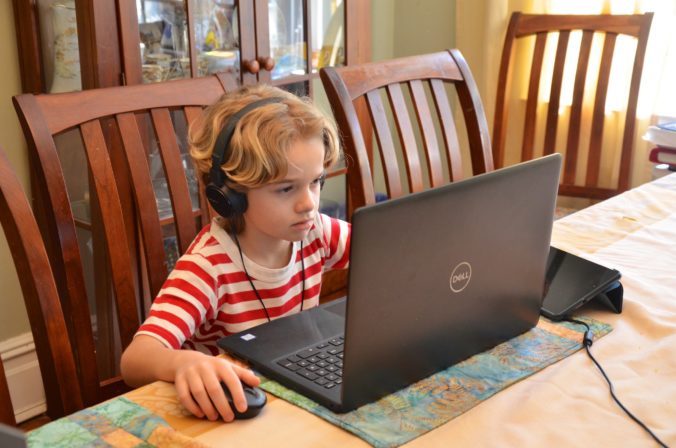As primary teachers, we are well aware that the relationships we form with our students are the key to helping our young learners be successful. This past spring, our online experiences revealed that there will be new challenges this coming September, especially if we have no in-person time with students. Often learners don’t like to talk, even when you meet them in person. Our meetings online with students resulted in a mixed experience. Some students participated less with their parents present in the room, and it was really hard to get the safe community feeling of the classroom back again.
The role of parents and caregivers of primary-aged students is different from that of older learners as adults often have to take on the teacher role as well as tech support, counsellor, and manager. For example, younger learners need help with planning their time, using the technology, printing and organizing assignments, managing their energy, as well as completing and submitting work.
Because classroom culture and community are such a huge part of a primary classroom, our goal with our project was to find resources to keep that community feeling going during remote learning. In our post, Building Community With and Between Our Learners, we decided to look at the relationships between the teacher and the students as well as between the students themselves. In Tips for Supporting and Connecting with Families, we also explored resources written to help with parent communication, which we also felt was a challenge during our time of remote learning, because parents immediately became members of our class experience, too. Below indicates the outcomes we pursued for this project.
Outcome #1: By the start of the year, primary educators will be able to build appropriate online relationships with their learners.
|
Outcome #2: By the start of the year, primary educators will be able to build appropriate online relationships between their learners, both in-class and online.
|
Outcome #3: By the start of the year, primary educators will be able to build appropriate online relationships with their learners’ families.
|
 We began this project by searching the internet for articles, blog posts, and Twitter feeds that addressed the concerns of building online and blended communities, and supporting parents. Below are some of the search engine descriptions we used:
We began this project by searching the internet for articles, blog posts, and Twitter feeds that addressed the concerns of building online and blended communities, and supporting parents. Below are some of the search engine descriptions we used:
- “relationship building in the online classroom”
- “building community in online learning environment primary school”
- “building community in online learning environment”
- “online relationship between teachers and parents”
- “building community online with kindergarten”
- “building community online with early learners”
We then began to check them against a rubric for evaluating resources. We used the Berkeley Library’s rubric for evaluating resources. We found this rubric to be clear and concise, with additional information to think about if we were unclear about a specific resource. The following is an example of how we used the criteria against the Berkeley rubric:
| Resource | Evaluation |
| Five Virtual Ways to Build a Classroom Community |
|
Some of the resources we found are not backed by prominent organizations and PhDs so, in addition to the Berkley rubric, we evaluated them against our own expertise and experiences with our own learners. Also, we are unsure of how to assess these sites and posts for accessibility; however, as all of our resources are web-based posts, platforms like Google and Twitter have built-in tools that can be used to assist with many accessibility issues. Almost all of the posts we gathered information from scored well against this rubric. The most commonly missing element was the documentation of sources within the post. Many resources are also plagued by advertisements so users need to beware of corporate interests. We found the resources we chose grouped themselves into five main categories:
- Sites like Edutopia and ISTE, backed by foundations or organizations with things like boards of directors or mission statements, often had posts that were written by higher-level educators about topics within their field of expertise.
- Other sites, such as the ones from Bored Teacher, We Are Teachers, Tech & Learning, had well-written posts by teacher contributors, but the sites might also have posts related to sponsored content. These sites also identify with the “Teacher Lounge” idea as a place for teachers to share their advice and classroom ideas. For these posts, we had to look a little harder to find the information needed to mark them against the rubric.
- Some of the curated posts were not specifically associated with a primary classroom, but we felt that the ideas or resources described could be adapted to meet the needs of a primary class. Posts like Engaging Students: Puppets in Online Education, which is intended for English as a Second Language Educators, or Caring for the Parent-Teacher Relationship during COVID-19, which is aimed at the middle school level, had adaptable ideas to help with either creating community or parent relationships.
- Social media links, such as from Twitter and Instagram, posed a different problem when marking against the rubric. Some Twitter searches yielded great links to interesting ideas or sites, but it really depended on who you followed or which hashtags you found. Luckily, we had been in recent contact with Alec Couros who mentioned a relevant question he had posted. As well, Pernille Ripp’s Twitter stream was recommended by a fellow cohort member and we noticed she has over 71,000 followers including many educators we know and trust. In exploring both Twitter feeds, we have discovered more educators to add to our Personal Learning Networks.
- We had only one or two sites that had good information for parents but were obviously trying to sell a specific program or platform. However, we felt that the information given could be applied to other situations and offered some good tips.
This past spring, we discovered that some of our tried and true in-class strategies did not work in the emergency remote learning environment. We needed to experiment with new techniques; some that worked for our colleagues did not work for us and vice versa, especially with primary learners. Because every teacher is different and every group of children is different, introducing new ideas for building a responsive, safe, social “classroom” community may also need to be experimental. The resources we gathered have ideas that may be proven for the authors but meet varying levels of success with different educators. We believe this list offers some exciting ideas, and we are looking forward to implementing many of them in the likely event that we will be engaged in some form of remote learning this coming school year. We know they will meet with varying levels of success, but we believe in the value of trying new things. We invite educators to try them with us and join the conversation at #remoteteachingresources.
“Everett At School” by Joe Shlabotnik is licensed under CC BY-NC-SA 2.0
“3d man with magnifying glass looks at folders. Choice concept.” by solutionist999 is licensed under CC BY-NC 2.0

Recent Comments